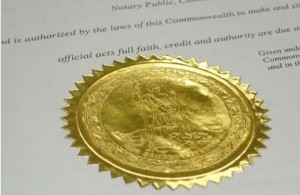VoxPopuLII
 In 1494, Luca Pacioli published “Particularis de Computis et Scripturis,” which is widely regarded as the first written treatise on bookkeeping. In the 600+ years since that event, we have become completely accustomed to the concepts of ledgers, journals and double-entry bookkeeping. Like all profound ideas, the concept of a transaction ledger nowadays seems to be completely natural, as if always existed as some sort of natural law.
In 1494, Luca Pacioli published “Particularis de Computis et Scripturis,” which is widely regarded as the first written treatise on bookkeeping. In the 600+ years since that event, we have become completely accustomed to the concepts of ledgers, journals and double-entry bookkeeping. Like all profound ideas, the concept of a transaction ledger nowadays seems to be completely natural, as if always existed as some sort of natural law.
Whenever there is a need for detailed, defensible records of how a financial state of affairs (such as a company balance sheet or a profit and loss statement) came to be, we employ Pacioli’s concepts without even thinking about them any more. Of course you need ledgers of transactions as the raw material from which to derive the financial state of affairs at whatever chosen point in time is of interest. How else could you possibly do it?
Back in Pacioli’s day, there was nothing convenient about ledgers. After all, back then, all ledger entries had to be painstakingly made by hand into paper volumes. Care was needed to pair up the debits and credits. Ledger page totals and sub-totals had to checked and re-checked. Very labor intensive stuff. But then computers came along and lo! all the benefits of ledgers in terms of the rigorous audit trail could be enjoyed without all the hard labor.
Doubtless, somewhere along the line in the early days of the computerization of financial ledgers, it occurred to somebody that ledger entries need not be immutable. That is to say, there is no technical reason to carry forward the “limitation” that pen and ink imposes on ledger writers, that an entry – once made – cannot be changed without leaving marks on the page that evidence the change. Indeed, bookkeeping has long had the concept of a “contra-entry” to handle the immutability of pen and ink. For example, if a debit of a dollar is made to a ledger by mistake, then another ledger entry is made – this time a credit – for a dollar to counter-balance the mistake while preserving the completeness of the audit-trail.
Far from being a limitation of the paper-centric world, the concept of an “append-only” ledger turns out, in my opinion, to be the key to the trustworthiness and transparency of financial statements. Accountants and auditors can take different approaches to how information from the ledgers is grouped/treated, but the ledgers are the ledgers are the ledgers. Any doubt that the various summations accurately reflect the ledgers can readily be checked.
Now let us turn to the world of law. Well, law is so much more complicated! Laws are not simple little numerical values that fit nicely into transaction rows either in paper ledgers or in database tables. True, but does it follow that the many benefits of the ledger-centric approach cannot be enjoyed in our modern day digital world where we do not have the paper-centric ledger limitations of fixed size lines to fit our information into? Is the world of legal corpus management really so different from the world of financial accounting?
What happens if we look at, say, legal corpus management in a prototypical U.S. legislature, from the perspective of an accountant? What would an accountant see? Well, there is this asset called the statute. That is the “opening balance” inventory of the business in accounting parlance. There is a time concept called a Biennium which is an “accounting period”. All changes to the statute that happen in the accounting period are recorded in the form of bills. bills are basically accounting transactions. The bills are accumulated into a form of ledger typically known as Session Laws. At the end of the accounting period – the Biennium – changes to the statute are rolled forward from the Session Laws into the statute. In accounting parlance, this is the period-end accounting culminating in a new set of opening balances (statute), for the start of the next Biennium. At the start of the Biennium, all the ledger transactions are archived off and a fresh set of ledgers is created; that is, bill numbers/session law numbers are reset, the active Biennium name changes etc.
I could go on and on extending the analogy (chamber journals are analogous to board of directors meeting minutes; bill status reporting is analogous to management accounting, etc.) but you get the idea. Legal corpus management in a legislature can be conceptualized in accounting terms. Is it useful to do so? I would argue that it is incredibly useful to do so. Thanks to computerization, we do not have to limit the application of Luca Pacioli’s brilliant insight to things that fit neatly into little rows of boxes in paper ledgers. We can treat bills as transactions and record them architecturally as 21st century digital ledger transactions. We can manage statute as a “balance” to be carried forward to the next Biennium. We can treat engrossments of bills and statute alike as forms of trail balance generation and so on.
Now I am not for a moment suggesting that a digital legislative architecture be based on any existing accounting system. What I am saying is that the concepts that make up an accounting system can – and I would argue should – be used. A range of compelling benefits accrue from this. A tremendous amount of the back-office work that goes on in many legislatures can be traced back to work-in-progress (WIP) reporting and period-end accounting of what is happening with the legal corpus. Everything from tracking bill status to the engrossment of committee reports becomes significantly easier once all the transactions are recorded in legislative ledgers. The ledgers then becomes the master repository from which all reports are generated. The reduction in overall IT moving parts, reduction in human effort, reduction in latency and the increase in information consistency that can be achieved by doing this is striking.
For many hundreds of years we have had ledger-based accounting. For hundreds of years the courts have taken the view that, for example, a company cannot simply announce a Gross Revenue figure to tax officials or to investors, without having the transaction ledgers to back it up. Isn’t in interesting that we do not do the same for the legal corpus? We have all sorts of publishers in the legal world, from public bodies to private sector, who produce legislative outputs that we have to trust because we do not have any convenient form of access to the transaction ledgers. Somewhere along the line, we seem to have convinced ourselves that the level of rigorous audit trail routinely applied in financial accounting cannot be applied to law. This is simply not true.
We can and should fix that. The prize is great, the need is great and the time is now. The reason the time is now is that all around us, I see institutions that are ceasing to produce paper copies of critical legal materials in the interests of saving costs and streamlining workflows. I am all in favour of both of these goals, but I am concerned that many of the legal institutions going fully paperless today are doing so without implementing a ledger-based approach to legal corpus management. Without that, the paper versions of everything from registers to regulations to session laws to chamber journals to statute books – for all their flaws – are the nearest thing to an immutable set of ledgers that exist. Take away what little audit trail we have and replace it will a rolling corpus of born digital documents without a comprehensive audit trail of who changed what and when?…Not good.
 Once an enterprise-level ledger-based approach is utilised, another great prize can be readily won; namely, the creation of a fully digital yet fully authenticated and authoritative corpus of law. To see why, let us step back into the shoes of the accountant for a moment. When computers came along and the financial paper ledgers were replaced with digital ledgers, the world of accounting did not find itself in a crisis concerning authenticity in the way the legal world has. Why so?
Once an enterprise-level ledger-based approach is utilised, another great prize can be readily won; namely, the creation of a fully digital yet fully authenticated and authoritative corpus of law. To see why, let us step back into the shoes of the accountant for a moment. When computers came along and the financial paper ledgers were replaced with digital ledgers, the world of accounting did not find itself in a crisis concerning authenticity in the way the legal world has. Why so?
I would argue that the reason for this is that ledgers – Luca Pacioli’s great gift to the world – are the true source of authenticity for any artifact derived from the ledgers. Digital authenticity of balance sheets or Statute sections does not come from digital signatures or thumb-print readers or any of the modern high tech gadgetry of the IT security landscape. Authenticity come from knowing that what you are looking at was mechanically and deterministically derived from a set of ledgers and that those ledgers are available for inspection. What do financial auditors do for living? They check authenticity of financial statements. How do they do it? They do it by inspecting the ledgers. Why is authenticity of legal materials such a tough nut to crack? Because there are typically no ledgers!
From time to time we hear an outburst of emotion about the state of the legal corpus. From time to time we hear how some off-the-shelf widget will fix the problem. Technology absolutely holds the solutions, but it can only work, in my opinion, when the problem of legal corpus management is conceptualized as ledger-centric problem where we put manic focus on the audit trail. Then, and only then, can we put the legal corpus on a rigorous digital footing and move forward to a fully paperless world with confidence.
From time to time, we hear an outburst of enthusiasm to create standards for legal materials and solve our problems that way. I am all in favour of standards but we need to be smart about what we standardize. Finding common ground in the industry for representing legislative ledgers would be an excellent place to start, in my opinion.
Is this something that some standards body such as OASIS or NIEM might take on? I would hope so and hopeful that it will happen at some point. Part of why I am hopeful is that I see an increasing recognition of the value of ledger-based approaches in the broader world of GRC (Governance, Risk and Compliance). For too long now, the world of law has existed on the periphery of the information sciences. It can, and should be, an exemplar of how a critical piece of societal infrastructure has fully embraced what it means to be “born digital”. We have known conceptually how to do it since 1494. The technology all exists today to make it happen. A number of examples already exist in production use in legislatures in Europe and in the USA. What is needed now, is for the idea to spread like wildfire the same way that Pacioli’s ideas spread like wildfire into the world of finance all those years ago.
Perhaps some day, when the ledger-centric approach to legal corpus management had removed doubts about authenticity/reliability, we will look back and think digital law was always done with ledgers, just as today we think that accounting was always done that way.
 Sean McGrath is co-founder and CTO of Propylon, based in Lawrence, Kansas. He has 30 years of experience in the IT industry, most of it in the legal and regulatory publishing space. He holds a first class honors degree in Computer Science from Trinity College Dublin and served as an invited expert to the W3C special interest group that created the XML standard in 1996. He is the author of three books on markup languages published by Prentice Hall in the Dr Charles F. Goldfarb Series on Open Information Management. He is a regular speaker at industry conferences and runs a technology-oriented blog at http://seanmcgrath.blogspot.com.
Sean McGrath is co-founder and CTO of Propylon, based in Lawrence, Kansas. He has 30 years of experience in the IT industry, most of it in the legal and regulatory publishing space. He holds a first class honors degree in Computer Science from Trinity College Dublin and served as an invited expert to the W3C special interest group that created the XML standard in 1996. He is the author of three books on markup languages published by Prentice Hall in the Dr Charles F. Goldfarb Series on Open Information Management. He is a regular speaker at industry conferences and runs a technology-oriented blog at http://seanmcgrath.blogspot.com.
VoxPopuLII is edited by Judith Pratt. Editors-in-Chief are Stephanie Davidson and Christine Kirchberger, to whom queries should be directed.





[…] McGrath of Propylon has posted Digital Law: What Lawyers Need to Learn from Accountants, at […]
Law’s Box Revisited
I applaud the ingenuity of this author, a fellow Kansas no less, for his insightful application of Pacioli’s ledger’s to statutory authentication. Bravo!
My concern is that in our effort’s to solve the problem of statutory authentication, we will change law’s information environment in such a way as to have unforeseen, and perhaps undesirable effects, upon the more important issues of interpretation and application statutory law to the “actual cases and controversies.”
Providing the draft’s, the journal entries of Pacioli’s system, for each statute means that reciting legislative history will become an unavoidable feature of every argument featuring statutory interpretation proffered before a court. Despite what we may have become familiar with in federal contexts, this is not universally the case today because many state codes simply don’t have much in the way of legislative history, if anything at all. Indeed, many state courts may not want to encourage this kind of discourse, as I discovered in effort, ultimately successful, to to facilitate access to Missouri’s 1943-1944 constitutional debates.
Am I really taking the position, that we shouldn’t encourage the widest possible access to legislative materials? Not necessarily, what I am saying is that we should look before we leap. There is a Heisenberg uncertainty problem here–our efforts to measure one facet of law–authenticity–may fundamentally affect another facet–interpretation.
Now, I know that some may wonder whether I can really argue with a straight face that less access is actually preferable to more when it comes to the law. Historically, I am not the first to take that position.
To illustrate, a wonderful feature of when early law of the Britain was preserved by the memory in the “unwritten law” was that it could be conveniently forgotten. Per the noted legal historian and diplomatist, M.T. Clanchy, “Memory, that ‘marvelous instrument of elimination and transformation’ . . . is continually changing. . . . [C]ustoms were ‘instruments for legal change rather than the fossilized remains of a remote bast.'” See Remembering the Past and the Good Old Law 55 Hist. 165, 172 (1970). It is interesting that a celebrated historian’s verdict was that a virtue of common law (prior, in its original sense, of being written) was that it could be forgotten. There was such a thing as “too much law” and from time to time some of it needed to be replaced by something new, and potentially at odds with the unwritten past.
Justinian took a similar position when he decreed that legal works prior to his Corpus Juris Civilis, the very works he used to compile the same, be banished. He also forbade the preparation of new commentaries on his work. See John Henry Merryman, The Civil Law Tradition: An Introduction to the Legal Systems of Western Europe And Latin America 8 (1969).
As a librarian, it would be against my own version of the “Hippocratic oath” to argue against access to legislative information, but as an aspiring information scientist, my duty is to point out that we need to consider are the larger ramifications. Changing the information environment through a ledger system for legislation, for purposes of authentication, will have other consequences.
In the modern context, it means that the same problems which we find in the increasing scale of accessible case law, which have shifted our legal system’s balance from an emphasis on case law to legislative and regulatory schemes, may undermine those schemes as well. We may frequently find ourselves desperate for complete re-codifications of our statutory and regulatory law, both federal and state. We might even secretly desire the power of Justinian–to forbid future amendment of such codifications. It is with some irony, that I have periodically observed the complaints of legal academics–that the problem with legislatures is that they do just that, they legislate . . . and keep on legislating. Access to the bits of undigested meat, that comprise, the making of legislative sausage exacerbates the problem even further.
Well, its time to end my personal parade of exaggerated horribles. However, my point is not that there is potential for a nightmare. Rather, my conclusion is this–the problem with legal authority is larger than authentication.
As I have argue elsewhere, in an article by a similar title,”law
is a child in one of [B.F. Skinner’s] boxes, where environment and perception
(as influenced by environment) profoundly affect the development of a dynamic
organism.” If law is authenticated in the manner proposed by McGrath, it
will fundamentally change its evolution. Changing metaphors, at the
quantum level, the problem of authentication is inextricably interwoven with interpretation–and measuring one affects the other. In proposing systems for organizing the law–including laudable efforts to create standards or even markup languages to account for its various facets–we need something that will handle the big picture–authentication, interpretation, and the inherent tension between the two.
I absolutely loved this post by McGrath. I hope that it will stimulate further discussion, and solution, by many who can think through and resolve the issues better than I.
Paul
Certainly a very interesting post – it originally caught my eye in a different context. Here in the UK accountants have until now been streets ahead of lawyers when it comes to digital marketing. Whether due to lighter regulation or a more entrepreneurial approach, they have understood that clients and potential clients now look at a law firm and lawyers digital footprint closely, and the web is a fantastic conduit for cross selling. Lawyers are finally starting to catch up, about time !
[…] year, in Sean McGrath’s post on Digital Law, we were alerted to what lawyers need to learn from accountants. In this post, we present another […]